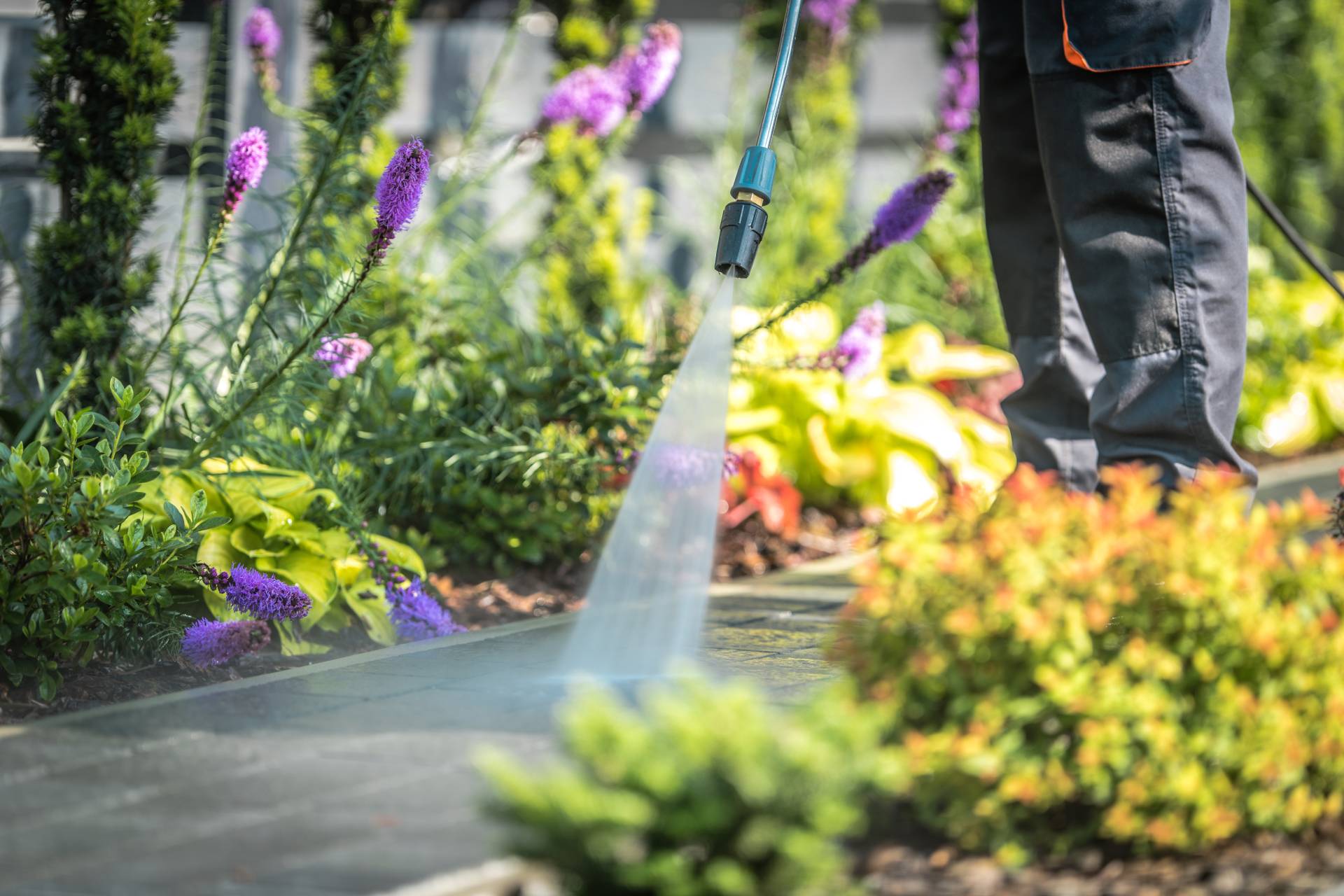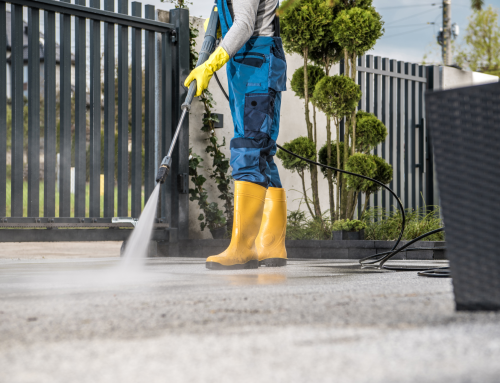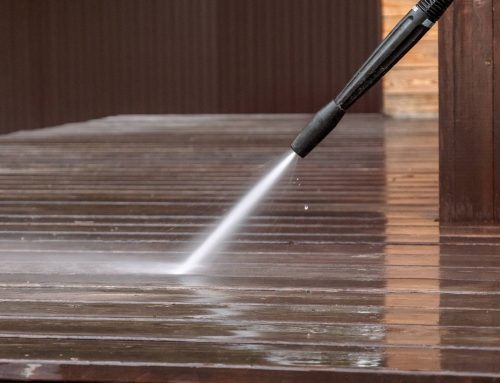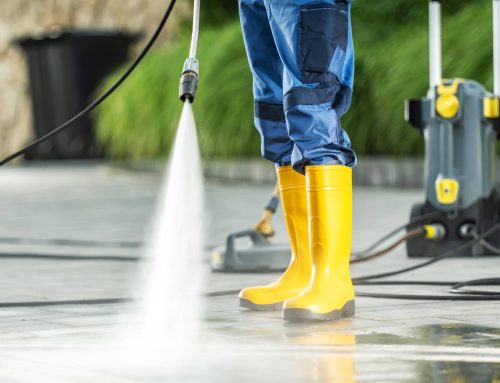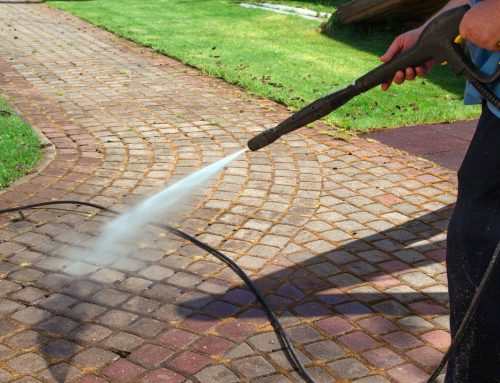Refreshing your exteriors can improve the look and feel of being home, as you spend more time outdoors these warm summer months. By having a clean exterior environment, you can feel more inspired and comfortable to relax and sit outside or to engage in outdoor activities, like gardening or sports. You might even want to invite your neighbours and friends to come over and spend time with us at our homes. However, deep cleaning surfaces like fences, decks, or patios, can take up a lot of time and effort. Power washing services provide an effective and easy way for you to clean up your outdoor surfaces and environment, so that you can maximize and enjoy your home’s outdoor amenities while the weather is warm and the days are long.
Power washing is an effective and thorough way to clean surfaces and to restore their natural looks. By using high-pressure water to remove dirt, grime, mold, mildew, algae, and other contaminants from various surfaces, power washing can make your home more visually appealing and make you feel more comfortable as you host picnics or barbecues. You can power wash various surfaces in your home’s exterior, such as your driveway, fences, deck, or patio. You can also use power washing services to clean your windows and exterior walls, which can give your home a refreshed appearance.
Summer brings ideal weather conditions and is a great time for power washing. Since the weather is generally warm and dry, the surfaces that you power wash can dry quickly after cleaning. You can achieve a thorough and effective cleaning without worrying about your surfaces remaining damp for too long. If you are thinking of making use of power washing services for your home, here are some tips for a successful and smooth cleaning experience:
1. Assess the Surfaces to be Cleaned
Power washing is an effective method to remove stubborn stains or deep-rooted grime. It can be done on various surfaces, but it is still important to verify if there are areas that might require special attention or caution. Not all surfaces can withstand the high-pressure water from power washing. As such, assessing the material of the surface helps determine whether power washing is appropriate or if it could cause damage to the surface. Different surfaces may require different levels of pressure for effective cleaning. It is important to note which surfaces are more delicate than the others to avoid causing damage during the process. If the surface is damaged or deteriorated, it might need to be repaired before starting the power washing process. Furthermore, it is important to check if the surfaces might be vulnerable to water intrusion. Some surfaces might need to be resealed to prevent water damage prior to power washing.
2. Remove Obstacles from the Area
Power washing makes use of high-pressure water to clean surfaces. With that said, it is important to remove any items that could obstruct the cleaning process. Removing obstacles ensures a safe environment for power washing, which can dislodge debris, objects, or loose materials. It also helps prevent damage to the items that are not intended to be power washed. Removing delicate objects, such as plants, decoration, or furniture, will ensure you have a clear area for power washing. It provides you with unobstructed access to the surfaces that need to be cleaned and to cover various angles to clean the surfaces evenly. Having obstacles in the area could make it challenging to reach tight spaces or corners and could result in an unevenly cleaned surface. Finally, removing obstacles ahead of time can save you time and effort for the power washing process and minimizes the amount of clean up that needs to be done after the session.
3. Trim Overgrown Vegetation
Trimming overgrown vegetation, such as bushes, branches, or vines, can help provide unobstructed access to the surfaces you intend to power wash. Overgrown vegetation can trip dirt, debris, and grime and can prevent a thorough and effective cleaning of the underlying surfaces. In addition, the high-pressure water from power washing can cause damage to plants that are in the way. Trimming shrubs and bushes can reduce the risk of accidentally damaging or uprooting them during the cleaning process. Finally, trimming overgrown bushes, branches, or vines in advance can minimize the amount of plant debris that needs to be cleaned up after power washing. By trimming overgrown vegetation in advance, you can streamline the power washing process and keep your exteriors neat and tidy.
4. Protect Nearby Objects and Surfaces
Power washing can inadvertently cause damage to nearby objects or structures. If there are any objects, such as windows or large furniture, that cannot be easily removed from the area, they should be protected from potential water damage. Nearby objects and surfaces should be covered with plastic sheeting or tarps to avoid overspray from power washing. Delicate objects should be protected accordingly. In addition, although power washing will be done on exterior surfaces, it is important to keep your doors and windows closed during the process. This will protect your home and prevent high-pressure water from entering it. Water entering through open windows and doors can damage walls, floors, carpets, appliances, and furniture. Water intrusion could create a damp environment that is conducive to mold and mildew growth. Furthermore, water entering your home could disrupt indoor activities and routines. As you refresh your exterior environment, it is also important to keep a comfortable indoor environment within your home. To minimize risks from water damage, closing doors and windows is a preventive measure that can be done when power washing.
5. Remove and Clean Up Loose Debris
If the surfaces you intend to clean have loose debris, such as leaves, dirt, dust, or twigs, that can easily be removed, it is a good idea to remove them prior to power washing. The high-pressure water from power washing may dislodge and scatter loose debris around and lead to a messy clean up after the cleaning session. Moreover, loose debris can act as barriers to effectively reaching and cleaning the underlying surfaces. Removing debris can ensure a consistent and uniform appearance after power washing. By cleaning the surfaces from loose debris, your power washers can more efficiently and effectively clean the surfaces. It is also important to ensure that there is a clear drainage path prior to power washing. Debris might obstruct the flow of water and lead to water pooling. Cleaning out loose debris from the area can ensure proper drainage of the water.
Power washing can help you clean up your home’s exterior and make it look and feel more inviting to your family and your guests. It is an effective way to clean your driveway, deck, patio, or fences if you are planning to host family, friends, and neighbors. You can also take advantage of power washing services to prepare your house for a new coat of paint or for the general maintenance of your exterior walls and windows. However, power washing requires specific tools, equipment, and skills to ensure a job well done. A reputable contractor that provides power washing services will possess state of the art tools and equipment needed to achieve the appropriate water pressure without damaging your exterior surfaces. They can cater to your needs and will have the skills and expertise needed to evenly and thoroughly clean various surfaces. As you prepare your home for a summer of social outdoor events, consider hiring power washing services to freshen up your home’s exterior and to make summer cleaning easy.

